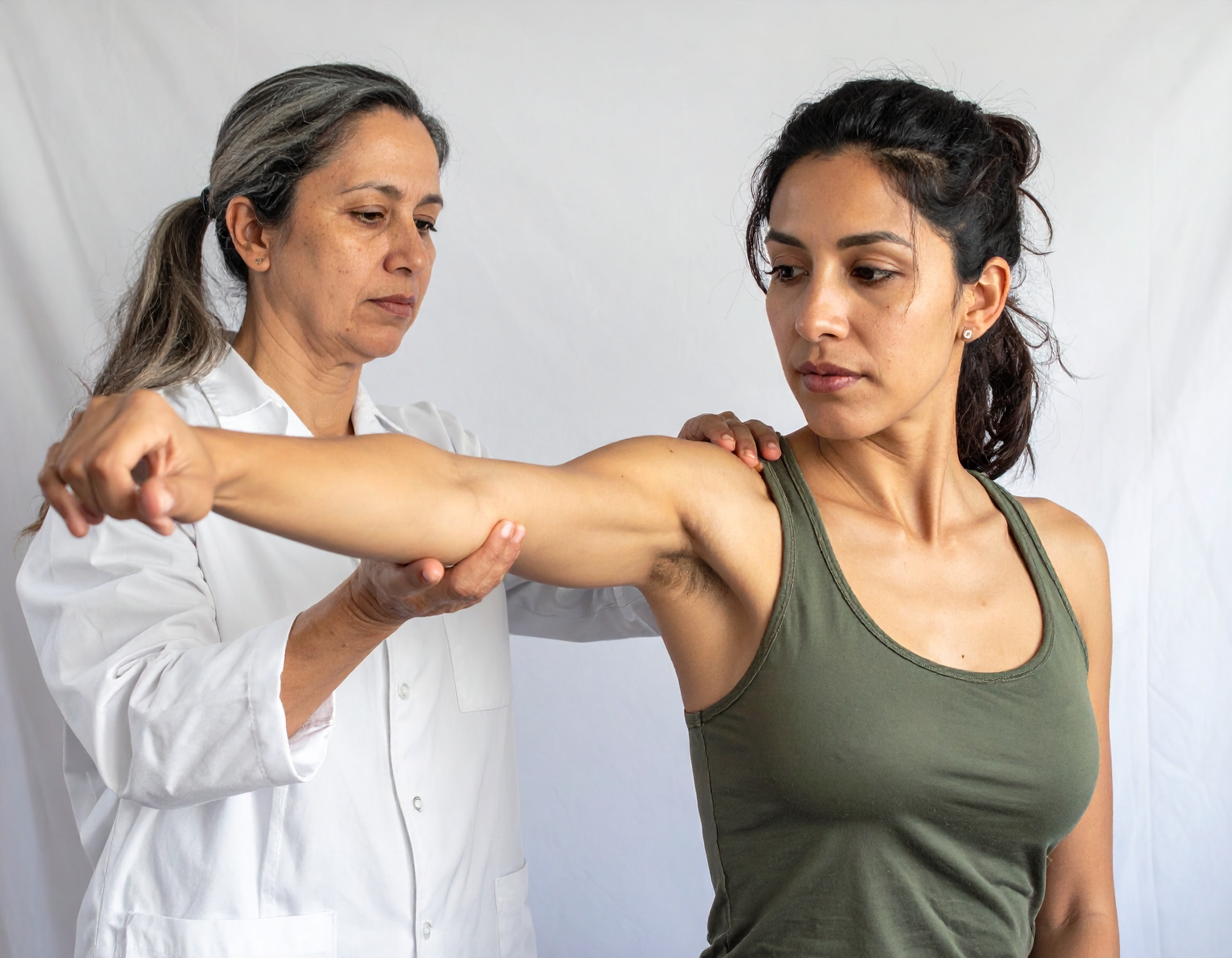Shoulder pain can limit daily activities, but with the right information and care, relief is possible. This article reviews common causes and solutions.
Key Points
- Shoulder pain may be caused by instability, bursitis, tendinitis, or impingement. Recognizing the cause helps ensure effective treatment. Early diagnosis using medical history, exams, and imaging supports proactive management.
- Non-surgical treatments like physical therapy and lifestyle changes, as well as surgical options for severe cases, can improve shoulder health and function.
How Shoulder Rotation Works
The shoulder enables arm movements such as lifting, reaching, and rotating. It is a joint where the upper arm bone (humerus) connects with the shoulder blade (scapula), and pain often arises from the shoulder joint and its surrounding structures. The shoulder joint works in coordination with other parts of the body during movement, as soft tissues link the shoulder to other areas. The rotator cuff, composed of four muscles and their tendons, stabilizes the joint and allows smooth motion. Tendons are strong, fibrous tissues that attach muscles to bones.
Though often called a simple ball-and-socket joint, most people think the shoulder is straightforward, but it is actually a complex structure and prone to shoulder problems. The humerus has a rounded head (humeral head) that fits into the socket of the scapula, playing a crucial role in joint stability and movement. Its frequent use increases vulnerability, but most conditions are treatable, allowing return to comfort and mobility.
Identifying the cause of shoulder pain is essential for effective recovery.
Common Causes of Shoulder Pain
Shoulder pain can stem from different issues in the joint and nearby tissues. With proper care, comfort and function can often return. Repetitive overhead movements in sports or excessive force commonly leads to instability, inflammation, or bursitis. Tendinitis and fractures of the clavicle or humerus are also commonly seen causes of shoulder pain. Some shoulder pain may be temporary and resolve without intervention. Pain may also be referred from the chest or neck, so consider these areas during evaluation.
Signs such as pain or swelling are symptoms of underlying shoulder problems. Understanding these causes aids diagnosis and treatment. Infection, though rare, should also be considered. If symptoms persist, consult a provider for proper diagnosis and treatment.
Bursitis
A bursa is a small, fluid-filled sac that cushions the shoulder joint and prevents friction between bones and soft tissues. Bursitis happens when the bursae—tiny, fluid-filled sacs that cushion and protect joints—become inflamed. Overuse can cause swelling, pain, and visible inflammation around the joint, making daily activities difficult.
Bursitis is often managed with physical therapy focused on muscle strengthening and inflammation reduction, allowing return to daily activities with less pain.
Tendinitis
Tendinitis is inflammation of the tendons, which are strong bands of tissue that connect muscles to bones. In the shoulder, tendons most often affected are those of the rotator cuff (which connect the four rotator cuff muscles to the upper arm bone) and the biceps tendon (which links the biceps muscle to the shoulder). Inflammation here can cause pain and limit movement.
These tendons are vital for shoulder motion and stability. Tendinitis usually follows repetitive stress or overuse, especially in athletes and active people.
Rest, physical therapy, and anti-inflammatory medications can reduce tendinitis symptoms and support return to activity.
Tendon Tears
Tendon tears, which often affect the rotator cuff and biceps, are serious shoulder injuries. These tears can be partial or complete, depending on the severity, and result from tearing of the tendon tissue due to injury or prolonged stress. Without treatment, shoulder movement can become very difficult.
Early diagnosis and treatment can prevent damage and restore function. Physical therapy, and surgery if needed, help regain strength and mobility.
Shoulder Impingement
Shoulder impingement occurs when the acromion—a bony projection on the shoulder blade—presses against the rotator cuff tendons and other soft tissues during arm movement. This compression can cause bursitis and tendinitis, resulting in pain and limited movement.
Shoulder impingement is more common in adults over 60. Repetitive overhead tasks, such as carpentry or painting, raise risk. With proper treatment and lifestyle changes, many experience relief and improved function.
Shoulder Instability
Shoulder instability means the upper arm bone dislocates from the socket, causing pain and limited function. It often results from sudden injury but can become ongoing if ligaments and tendons are damaged.
Symptoms include looseness and frequent dislocations. Treatment usually involves physical therapy to strengthen muscles and improve stability. Surgery may be needed in severe cases. Osteoarthritis is gradual cartilage wear, causing pain, cracking, or clicking.
Arthritis often starts in middle age and is more common after age 50. Early diagnosis, medications, and physical therapy can manage symptoms and support an active lifestyle.

Diagnosing Shoulder Pain
Proper diagnosis is key for shoulder pain treatment. Providers use their clinical practice and judgment to assess symptoms, review history, conduct exams, and may order images. This approach allows the provider to identify the cause and guides treatment.
Knowing previous shoulder injuries or conditions provides valuable insight to current symptoms and helps the provider develop an effective, individualized treatment plan.
Physical Examination
A physical exam helps find the cause of shoulder pain. This can include:
- Testing the range of motion
- Assessing the strength of the shoulder to identify underlying issues
- Doing specific tests to check shoulder stability and function
These tests provide key information that helps doctors determine the exact cause of pain and create a thorough treatment plan. For example, your doctor may recommend medications like ibuprofen, a common anti-inflammatory drug, to manage pain. This process ensures all aspects of your shoulder condition are considered.
Examination findings should be interpreted using evidence-based practices and clinical expertise to ensure accurate diagnosis and effective treatment.
Imaging Tests
Imaging tests show shoulder structures and problems. X-rays are used first for fractures or alignment issues.
Additional imaging, such as MRI, may be recommended to determine the cause of shoulder pain. These tests guide treatment decisions and address underlying issues.
Treatment Options for Shoulder Pain
Treatment options range from non-surgical to surgical interventions. Physical therapy for muscle strengthening and flexibility can reduce discomfort. Some shoulder pain may resolve naturally. Consulting a physical therapist ensures a personalized exercise plan.
Regular activity and strength training support the shoulder and reduce injury risk. Heat therapy helps relax muscles and ease stiffness. Managing muscle tightness is key, as these symptoms can limit movement and cause discomfort.
Initial management for shoulder discomfort includes:
- Modifying activities
- Resting
- Physical therapy
- Anti-inflammatory medications
Rest and lifestyle changes can support healing. Physical therapy improves strength and mobility, often effective for impingement. Medications, from OTC pain relievers to prescription anti-inflammatories, help manage pain.
Surgical Interventions
Surgery may be considered for persistent issues not responsive to non-surgical treatments. Options address conditions such as certain rotator cuff tears.
- Certain rotator cuff tears
- Arthroscopy is a minimally invasive surgical option that can address various shoulder conditions with shorter recovery times.
Shoulder replacement surgery may be needed for severe joint damage. Early action can help. Subacromial balloon spacers and reverse shoulder replacement are options for complex cases.
See Recommended Products

Preventing Shoulder Pain
Lifestyle changes and exercise help prevent shoulder pain. Avoid overuse in new tasks, maintain good posture, and stretch properly. Bursitis can result from repetitive motions that irritate the joint.
Ergonomic workspace adjustments significantly reduce strain. Gentle stretching helps maintain mobility and manage chronic pain.
Managing chronic shoulder pain requires a proactive approach. Maintaining good posture and making ergonomic adjustments can reduce overuse and repetitive stress injuries.
Regular mobility exercises support joint health and flexibility, helping prevent shoulder pain. Light cardio and dynamic stretches before activities can reduce injury risk.
Conclusion
Understanding the causes of shoulder pain and available treatments is essential for managing and preventing shoulder problems. Conditions such as bursitis, tendinitis, instability, and arthritis each require an individualized approach. We hope you found this article helpful. By following the tips and treatment options above, you can take control of your shoulder health. Early diagnosis and proactive management are key to preventing chronic issues and maintaining quality of life.
FAQs
What if my shoulder hurts?
If your shoulder hurts it could be arthritis, frozen shoulder, bone spurs or several other factors. Fortunately most shoulder pain can be managed at home so you can start feeling better soon!
What are the common causes of shoulder pain?
Shoulder pain can be from bursitis, tendinitis, tendon tears, shoulder impingement, instability and arthritis. Knowing the causes can help you take proactive steps towards relief and recovery!
How is shoulder pain diagnosed?
Shoulder pain is diagnosed through a thorough medical history, physical examination and imaging tests like X-rays and MRIs. This comprehensive approach helps identify the exact issue so you can get the right treatment and relief!
What are the non-surgical treatment options for shoulder pain?
You can get significant relief from shoulder pain through non-surgical treatments like physical therapy, rest, lifestyle changes and anti-inflammatory medications. Try these options and improve mobility and comfort.
When is surgery considered for shoulder pain?
Surgery is considered for shoulder pain when non-surgical treatments don’t work, especially for recurring dislocations or specific rotator cuff tears. If you’re experiencing ongoing pain, exploring surgical options could be the way to go!

